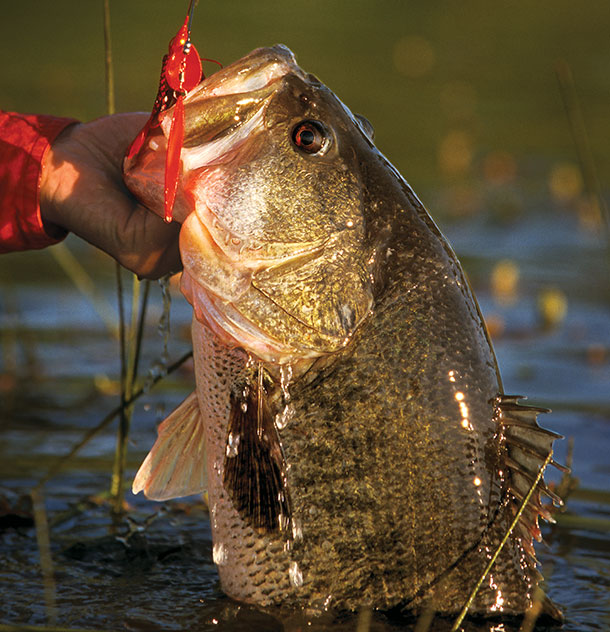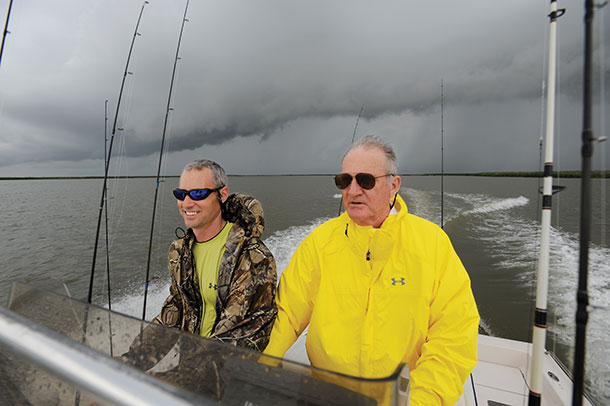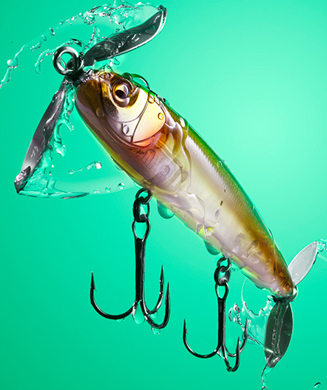Most fishermen who have chunked a plug have been hamstrung by cold-front conditions. Fish go on a hunger strike on clear, bright, bluebird days after a front passes, turning postcard-perfect weather into hours of sheer frustration. But don’t despair. Here’s where to find your favorite freshwater prey and coax those tight-lipped fish into the box.
Get in the Zone

Bass
Due to their propensity to hold in shallow water when foraging, largemouth and smallmouth bass are affected by cold fronts more than any other fish species. As a cold front approaches, bass in the shallows head for deeper water, where they hold tight to submerged structure. These comfort zones assume many forms: rock or brush piles, standing timber, riprap, root balls, or anything else they can hide in. Areas to search include deep-water ledges, channel turns, and secondary points close to primary shallow-water areas that bass typically frequent under non-cold-front conditions.
Because bass tend to suspend motionless under these conditions, an up-and-down presentation affords the best opportunity for bass to see your offerings. Vertically jigging a dwarf spoon or a ¼-ounce (or smaller) tube, or drop-shotting morsel-size creature baits, are great go-to tactics.
Go Deep

Walleyes
When a cold front rumbles through walleye country, fish will commute from their relative shallow-water feeding areas to deeper haunts. Unlike bass, though, walleyes are much easier to locate and catch.
Start your search on traditional shallow feeding flats and secondary points. Using your electronics (or a topographical map to shorten your search), check the immediate surrounding areas for the nearest drop-off. Monitor the steepest drops, as these tend to collect fish first.
Once you locate fish, keep in mind they are less active due to their slowed metabolism. The key to crowding the livewell is keeping the bait as static as possible in the strike zone. Vertical jigs rolled gently on a soft rod tip shine like no other cold-front technique.
Dead-sticking is a popular soft-plastic bass tactic for locked-down fish that proves deadly on weather-affected marble-eyes too.
Take ’em in Timber

Crappies
Speckled bass react much like largemouths and smallmouths when confronted with an unexpected cold push. Geographically, they’ll abandon the shallows—moving from coves and sloughs, for instance, into deeper creek channels in adjacent areas.
A solid rule of thumb for cold-front crappies is to pay close attention to your water-temperature gauge. If there is less than a 2-degree shift in water temperature, begin in the same coves or locations where non-cold-front crappies hang. If the water has cooled more than 2 degrees, start searching for submerged deep-water break.
Look in treetops, standing timber, brush piles, or any pronounced vertical structure and cover. Once you’ve pinpointed the fish, opt for presentations that will keep the bait close to cover. Marabou, soft-plastics, or tube jigs can crush cold-compromised crappies in short order. Stay very tight to structure.








